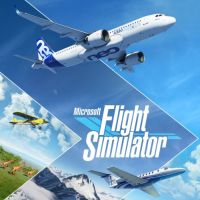Microsoft Flight Simulator: Toolbar
This chapter of the guide to Microsoft Flight Simulator tells all about the in-flight toolbar. We listed all the options and capabilities of the toolbar and suggest which are most useful.
The toolbar in Microsoft Flight Simulator is a mix of system of assistances and quick access to many important features. It can both simplify the gameplay, as well as is the cornerstone of the most realistic flight modes.
You can change the size and position of the toolbar windows, and even display them all at once, which can be useful if you have two monitors. Below is a description of all available toolbar functions.
- Toolbar display
- ATC
- Camera
- Checklist
- Basic controls
- AI control
- Fuel
- Nav Log
- Objectives
- Travel to
- VFR map
- Weather
- Custom toolbar
Toolbar display
To display the toolbar, move the cursor to the top of the screen in the middle and hover over to the white arrowhead. Moving the cursor away from this location will make the bar and the arrowhead disappear after a certain amount of time.
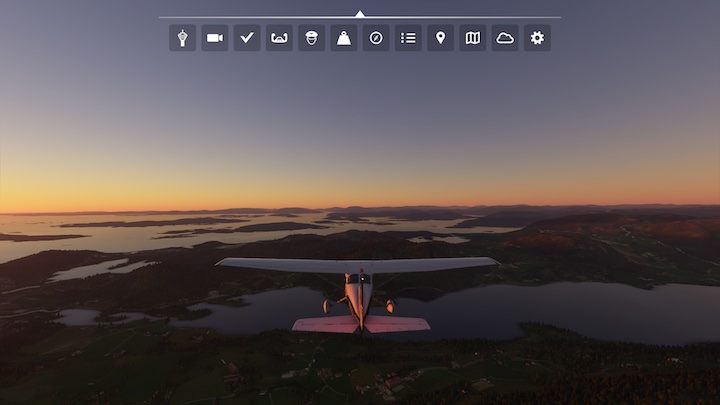
ATC
The first option on the left with the tower icon is ATC, or Air Traffic Control. It's simply a radio menu, where we can select available dialog lines to communicate with the air control to get permission to take off, land, get weather information etc. The ATC menu also allows to automatically tune the radio for a particular place (Tune in).
The ATC is also used during flights integrated with VATSIM servers , where real players actually enact the air traffic control, but this is a mode designed for the most advanced users.
In Microsoft Flight Simulator, the use of the ATC is generally optional, but it certainly increases immersion, enriches the atmosphere, and allows you to learn more about the secrets of civil aviation, so it's totally worth using it. Below, you will learn how to pass on the ATC service to the AI, which will choose the appropriate messages itself. It's a good way to start learning the appropriate phrases in the given circumstances.
The default key to call the ATC menu is Scroll Lock.
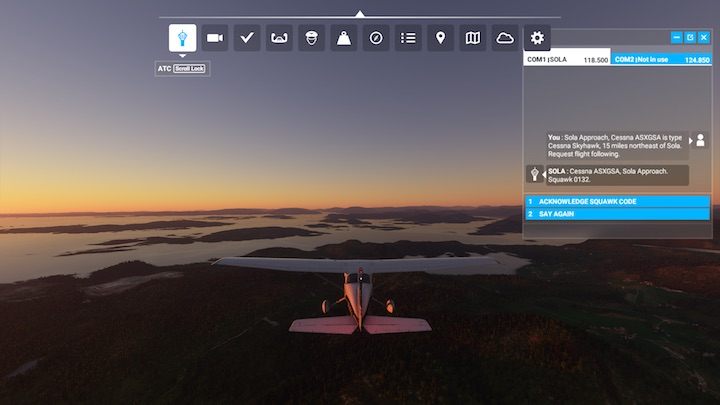
Camera
The camera allows you to customize camera views, which are quite complex in Flight Simulator 2020. There are separate tabs for the cockpit, exterior and cinematic cameras, we can customize various options, as well as go straight to predefined views.
Note that different options will be available for the default camera view for planes and different for drones. There are some angles that aren't assigned to any key, and can only be accessed here, such as the wing view in passenger planes.
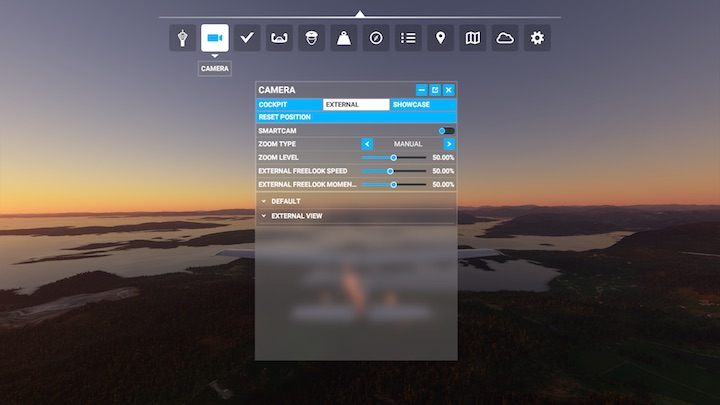
Checklist
The checklist is a very useful tool. It shows all the steps needed to start the plane, take off, fly, and taxi, all the way to parking the plane at its destination. It's sort of an equivalent to the kneeboard that pilots sometimes have attached to their thigh during flight.
It shows both necessary actions, such as turning the right switches, and additional info that only serves to build the atmosphere, even though it is required in reality - it can even be a visual assessment of the lack of damage on the wings.
A very useful option is the small eye icon on the right side of the list items. Clicking it will focus the camera and highlight the item that has to be used. Another tool is the option to mark the action as done - Tick item. It allows us to focus solely on important things.
Note that the eye icon does not apply to all items on the checklist. Only some aircraft in the game have complete lists of all activities. On large passenger planes, for example, there's only starting the engine there. This may change with updates.
We strongly recommend using checklists at the beginning of your flying. Over time, many of these things will be done by heart, but even then it's worth having a look to see if we haven't missed anything.
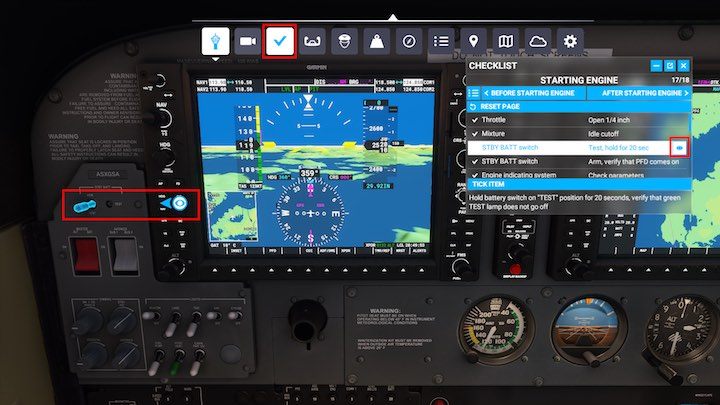
Basic controls
For the time being, only the controllers used by us are listed, along with the visualization of the names of the buttons. The default button to call this option is Left CTRL + C
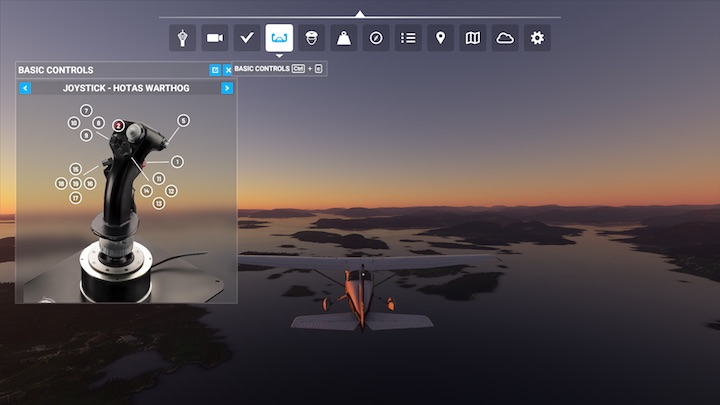
AI control
This option allows the AI to control several in-flight functions. These are:
- Checklist assist - AI itself takes all the neccesary steps
- Radio communications - all ATC communication takes place automatically (we can hear all the comms). This is very useful for learning when you should utter particular messages for the tower.
- Control of the aircraft - the default keys are left CTRL + ALT + X. This function relegates the controls to the AI, which will now maintain the course, speed and altitude. This works much like an autopilot, except it has nothing to do with the actual autopilot and is a completely separate assistance.
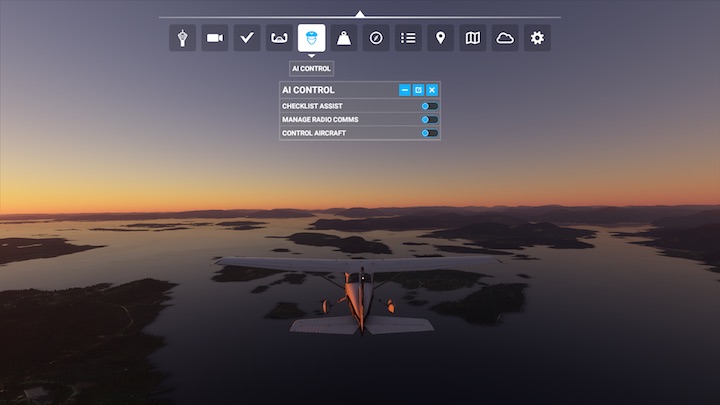
Fuel
Fortunately, the fuel menu doesn't entail economic dillemas. It is, however, essential for long journeys at the limit of a plane's range. It not only allows you to set the chosen amount of fuel in individual tanks, but also to adjust the weight of pilots and passengers on board, which also affects the range.
A heavy load of goods and passengers will translate into being able to carry less fuel, reducing the range. Similarly, the fewer passengers and luggage a plane takes, the more refuel it can carry, and hence fly further. Each machine has a take-off weight limit, beyond which it cannot lift into the air. In the summary at the end of the checklist, we should make sure that the total weight is less than the Max Take-off Weight.
The fuel menu will show up automatically if you call a tank truck while at the airport.

Nav Log
The navigation log is a virtual, a little simplified version of a document that each pilot must fill in before flying. It shows a list of navigation points (Name) along with their Heading, Distance in miles, and estimated flight time for each segment (ETE - Estimated Time Enroute). In addition, at the start of each stage, we can turn on the stopwatch and compare the estimated time with the actual time, which also helps to make sure we follow the right course.
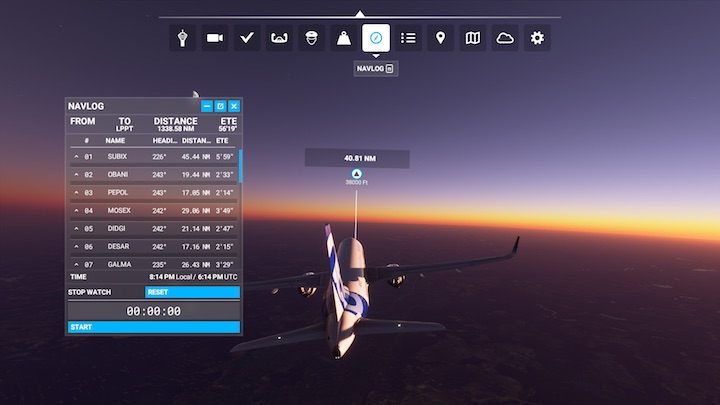
Objectives
The objectives work as in many other games, and they simply inform you about the subsequent stages of the flight to complete. In Flight Simulator, these must be specified by the task author. You can see them during training missions. If you are simply visiting the area, the field will be empty or will activate at later stages of the flight plan, e.g. before landing.
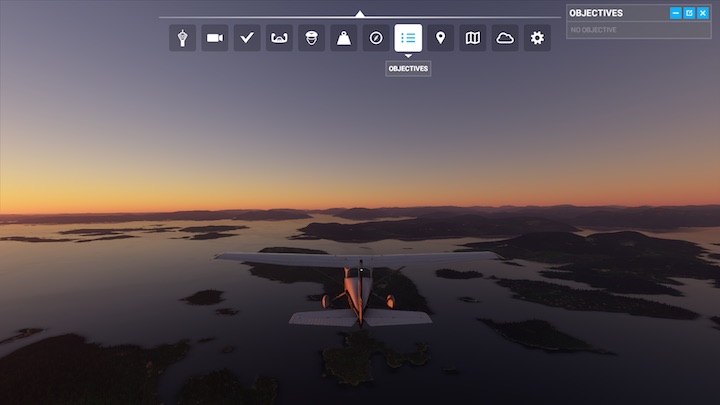
Travel to
This feature will only be active if you have pre-determined the entire flight plan including take-off, landing and intermediate navigation points in the world map mode. It allows you to quickly skip to the next stage of the flight, such as descent, starting landing approach, sitting on the runway or taxiing to a parking spot. Each skip requires a loading screen.
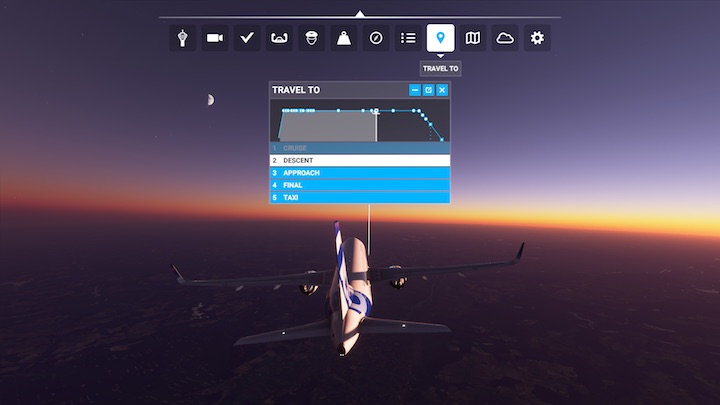
VFR map
The Visual Flight Rules map is like a handheld screen with GPS navigation. It shows the position of our plane and a fragment of the area below. We can move it freely with the mouse, as well as zoom in and out The GPS tracking option activates synchronization with the position of our aircraft, and the other one - the isoline map - represents changing ground elevation with isolines. This is useful in small aircraft, where you have to beware of tall mountains. The VFR map is mainly used on older aircraft, with an analog cockpits. Modern machines display the VFR on one of the screens.
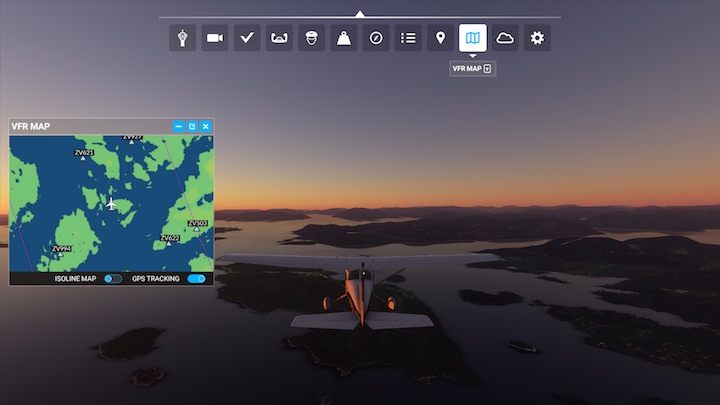
Weather
The weather editor in the toolbar is one of the most complex and important features in Flight Simulator 2020. Here, we can change the weather conditions and time of day in real-time, watching it coming to effect moments after clicking.
The top bar lets you select different types of clouds - from cloudless skies to thunderstorms and blizzards. The main panel on the left allows you to change the height of individual cloud layers and add wind.
The panel on the right is the date settings. Changing the date will influence the duration of sunlight, and allow you to observe real phases of the Moon, as well as solar eclipses. In addition, depending on the type of clouds you choose, you can also adjust the amount of precipitation, the thickness of the snow cover, the temperature, and the amount of lightnings in a storm.
Turning on the LIVE function cancels any choices and changes the weather to the current forecast downloaded from the network for the region (as long as the network functions are enabled in the main settings).

Custom toolbar
The last option allows you to disable selected toolbar functions. If we bet on absolute realism, we can disable the VFR map or take the control back from the AI. Users of VATSIM servers can disable the ATC tower chat function, etc.

- Microsoft Flight Simulator 2020 Guide
- Microsoft Flight Simulator: Game Guide
- Microsoft Flight Simulator: Basics
- Microsoft Flight Simulator: Beginner's Guide - how to start flying? Tips
- Microsoft Flight Simulator: Aircraft list
- Microsoft Flight Simulator: Airports list
- Microsoft Flight Simulator: Game modes
- Microsoft Flight Simulator: Toolbar
- Microsoft Flight Simulator: Realism level and assists
- Microsoft Flight Simulator: Ground Services
- Microsoft Flight Simulator: List of best mods
- Microsoft Flight Simulator: Basics
- Microsoft Flight Simulator: Game Guide
You are not permitted to copy any image, text or info from this page. This site is not associated with and/or endorsed by the developers and the publishers. All logos and images are copyrighted by their respective owners.
Copyright © 2000 - 2025 Webedia Polska SA for gamepressure.com, unofficial game guides, walkthroughs, secrets, game tips, maps & strategies for top games.
